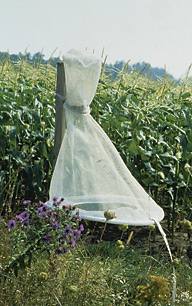Cornell pest-alert network helps link attacks to changing climates
By Mary Woodsen

A Cornell University "trap network," begun in 1994 to alert farmers when damaging pests are threatening 60,000 acres of sweet corn across New York state, could now help researchers track how these pests respond to changing climates.
Corn earworm is typically a late-season pest of sweet corn in upstate New York. Earworm adults -- pale brown moths -- migrate north each year, often arriving in mid-August. During the first years of the network, the special pheromone traps set up in July to monitor earworms remained empty for several weeks.
But an unexpected outbreak of earworm in Eden, N.Y., in June 1999 prompted researchers at the New York State Integrated Pest Management (IPM) Program, which is part of Cornell Cooperative Extension, to start looking more closely. Since then, low numbers of earworms -- with occasional spikes in their numbers requiring sprays -- have consistently turned up in traps in western New York from early June until the migratory flight kicks in during August.
"This is the sort of thing we anticipate seeing as climates shift," says Abby Seaman, a vegetable IPM extension educator with Cornell's IPM Program, who began the trap network. "We expect that insects will expand their range and reproduce more quickly. The network is giving us an idea of what pest pressure might look like in the future."
No one is sure yet if these early trap catches mean that corn earworm moths are overwintering in Eden, Seaman notes. "But higher trap catches of corn earworms trigger shorter spray intervals," she says. "Since IPM recommendations for corn earworm are based on trap catches, it's clear that earworms are already costing some farmers more than they did nine years ago."
The New York State IPM Program develops sustainable ways to manage pests and helps people to use methods that minimize environmental, health and economic risks.
Media Contact
Get Cornell news delivered right to your inbox.
Subscribe